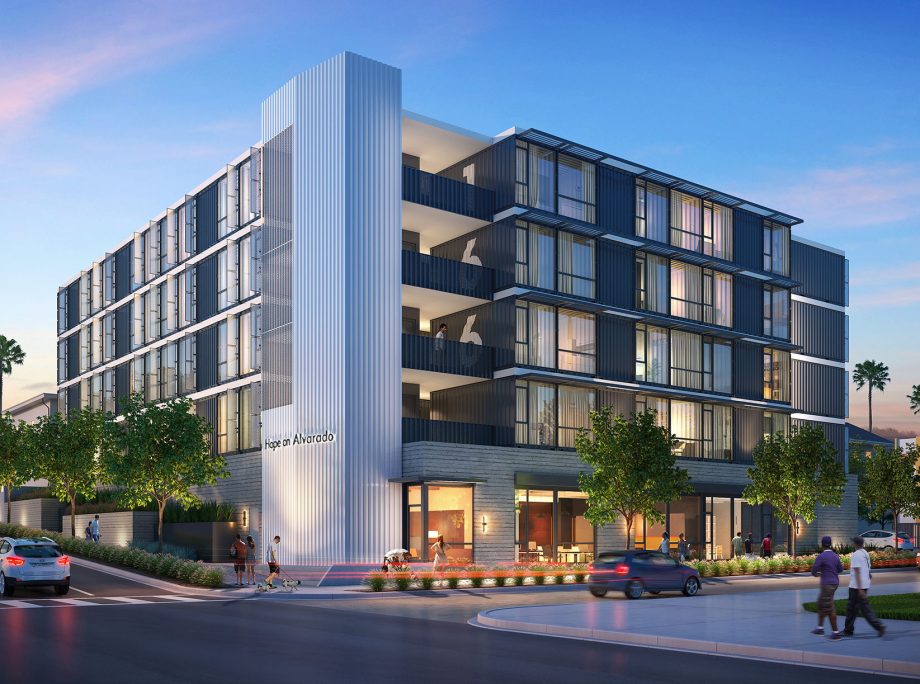Hope on Alvarado – Multifamily Industry ‘Ready for Modular’
Multifamily Executive
October 6, 2017
Shortening time lines is a magical concept in construction today. Especially when those time lines are being challenged by a variety of factors, including natural disasters such as the recent wildfires and hurricanes that hit parts of the country.
Trimming construction schedules was a prime objective of this year’s MFE Concept Community, which focused on new development processes to drive production efficiency and, therein, shorten construction time lines. The project’s main focus was modular construction, which the Concept Community team proved could save upward of 25% in time versus conventional construction methods.
“This project produced an overwhelming response from clients and new contacts,” says Erik Earnshaw, partner at BGO Architects, the firm that designed the 2017 Concept Community. “The industry is ready for modular, and most people are embracing it. I keep hearing that this is what we need to think about and where we need to go.”
Modular’s Assist to Affordable Housing
Earnshaw has found that some multifamily companies have already been experimenting with modular and are experiencing the same positive results he has. The time efficiencies involved, for one, are putting developers in a position to offer more affordable solutions and pass along the cost savings the time savings provide.
In some cases, the projects start with a focus on affordability.
KTGY Architecture + Planning is currently designing an affordable modular project being built with shipping containers to produce 84 units for homeless people in Los Angeles. The project, Hope on Alvarado, will reduce construction to a mere six months.
“One major advantage of using shipping containers is the dramatic reduction in construction time,” said Mark Oberholzer, AIA, LEED AP, and an associate principal with KTGY, in a press release. “While sitework and foundations are being constructed on-site, the containers are being manufactured off-site, including most interior finishes and fittings.”
Also in California, major tech giants are developing more affordable living solutions, including, as CNBC reports, Google parent company Alphabet, which plans to pay approximately $30 million to provide temporary, prefab housing for 300 of its employees.
Developers who can jump on board to meet a need for affordable housing will definitely gain an edge in several markets that are desperately in need of such solutions, Earnshaw says.
Shifting the Labor
Shortened construction times also mean lower construction costs, which doesn’t please everyone in the industry. After presenting the Concept Community at the Multifamily Executive Conference in September, Earnshaw heard from some contractors who worry that modular construction will mean less—or no—work for them.
But Earnshaw says going modular may just mean shifting the dynamics around. Prefab construction can mean less work on an individual project but more work overall because the shortened time lines will allow for more projects. Regardless of how long each construction phase lasts, modular building will change the dynamics of whom the developer needs and when, which will require a new scheduling strategy and approach.
Some developers, for example, could choose to have their own manufacturing plant and align themselves with specific subs who commit a number of workers to the plant. Those subs, be they plumbing or electrical or another trade, would report to the manufacturing facility and do the work there.
Or, Earnshaw says, developers could hire full time some of the workers they previously used as contractors, to be the reliable on-site staff that fit all the pieces together and know the process and program of the developer with whom they’re working. Many other solutions, as well, are conceivable, representing potentially a whole shift in the labor flow. That’s an opportunity in the making—especially when labor becomes a major challenge, as it is today.
Some architects, too, struggle with the concept of modular because they don’t want their designs to be compromised, and they don’t think modular has the flexibility or functionality to execute certain of their ideas. As prefab becomes more common, however, it is also growing nimbler and even expanding on some design ideas.
No Time to Wait
Despite misgivings among some in the apartment industry, many developers are forging ahead with modular, as reflected in the number of modular start-up companies that are overbooked. In fact, demand is so high, Earnshaw notes, that one developer he’s spoken with is aggressively pursuing learning how to do modular himself because he can’t wait for a prefab company in his area to free up. “He wants to start his own [modular outfit] because he knows that’s the future,” Earnshaw says.
Earnshaw understand’s his colleague’s eagerness. “The reception [we’ve received] to [the 2017 Concept Community] has been 10-fold what I was prepared for. Maybe I was naïve going into it; I know how hard it is for people to change their ideas. But [now], I can’t wait for what the future holds.”



